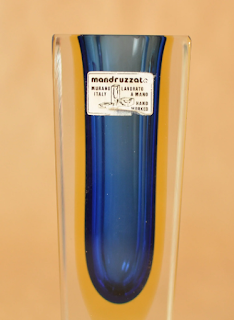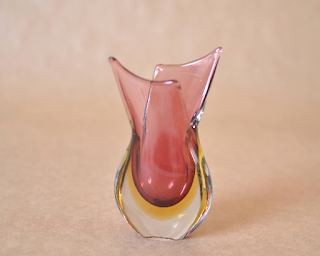It's
strange how things work. Sometimes you don't find a single Sommerso vase for
months, sometimes you find three on the same day! I hadn't seen any Murano
Sommerso vases in ages, and suddenly I find SIX pieces in less than a month
time. So weird. But obviously you don't hear me complaining, as they are
beautiful!
Here's
the thing: sometimes I wish I started collecting these glass Murano vases
instead of collecting West German pottery. The clean lines, the strong colours,
the way the light falls through a row of them in the window sill. Just
stunning.
Sommerso is Italian for Submerged. And that's a pretty great
description of what these vases actually are: a colour of glass submerged in
another colour of glass. Sommerso vases, as far as I know, always have at least
two layers of glass: a coloured layer on the inside, and a clear or a very
light coloured layer on top. (And for those of you who are now thinking:
"but I have a Sommerso vase in my collection that is entirely PINK, and
PINK ONLY", darn it, I knew they would be there, but couldn't find them on
Google!). Many of the vases have more than one coloured layer, I've seen vases
with as many as three or four colours. The extra layers mostly seem to be
yellow or blue, but I've seen a few with a light purple or green layer.
I'm not
entirely sure why they use these colours. I can imagine that it's because they
show the main colour of the item in the best possible way. Another reason could
be because of the contrast with the most used colours of Murano Sommerso glass:
red, green and blue.
Fun fact:
sometimes the yellow layer glows in the dark! Now, I don't own a black light,
so I can't test this out, but there are vases that used uranium glass for the
yellow layer.
The
particular vases I'm talking about in this post are clean lined: diamond shaped
or square. There are also bowls and ash trays to be found. They are often
described online as Mandruzzato style, or designed by Flavio Poli. I never
really knew what that meant. Were those makers/designers? Or was Mandruzzato an
Italian term for something, like Sommerso is?
So, I did
a little bit of digging. All the following information comes from other
websites, so please keep in mind that the internet is not as reliable as well
researched books. But I have put quite a bit of time in this, and they are good
sources so I promise it will be a worthwhile read*
Mandruzzato
is the name of a glass making family. Mandruzzato glass works was started in
1956 on the isle of Murano by Luigi Mandruzzato. In 1965 his son Gianfranco
joined the firm. From 2000 his son Alessandro took over the company. (sources:
here, here,
here).
The company website http://www.mandruzzato.ve.it/
sadly seems to be no longer functioning, but Alessandro's website is:
They
specialized in these layered, faceted pieces. Based on a forum posts byAlessandro in 2009, it looks like they made these vases for quite a while. Older pieces have an amber layer, later
pieces a yellow layer. And apparently the outer layer is crystal! I never knew
this.
One of
the vases I found last week had the original Mandruzzato label! It even shows
some of the shapes that were available.
In two forum posts (post 1, post 2) Alessandro mentions some names: the diamond shaped
vase is called S. Marco. The general name of this line of pieces seems to be
Molato (bevelled in English).
I have
seen a lot of other labels as well. Some examples are: VAM, VMP. I'm not sure if
these were generic Murano labels, or other factories who copied the design by
Gianfranco Mandruzzato. One of the labels I have seen was from Campanella, a
company that mostly made millefiori glass.
In addition to these faceted (copies?), they made another type ofvase that I find very pretty, with two smooth and two textured edges.
Confusingly enough, these are often also described to Mandruzzato in the online
stores. I couldn't find out if if Mandruzzato also made these, or if that is
just a later erroneous attribution.
Finally,
I want to come back to Flavio Poli. He was a designer for the company Seguso.
They did make Sommerso vases, but in a much more organic shape. The
"bow" vase is one of the designs that is attributed to him. One of
his vases is included in the MoMA! But it does look like he has nothing to do with the facetted vases.
To make
things even more complex, companies from other countries made similar kind of
vases: Strömbergshyttan made some organic Sommerso vases, but also a very
similar square model in earthy tones. The German company Harz Kristall made a
sort of up side down version in dark blue and red, that are very similar. Pavel
Hlava's glass vases are not identical, but again, very similar.
Wow, that
was a lot of info! It is a very confusing subject. For me the conclusion is
that I think they are all beautiful, but you shouldn't necessarily believe the
classification you see in webstores. I will go back to my current listings, and
update them with all this new info!
If you have more information to share on this
subject, I would love to hear it! You can send me a message, or leave a comment
below.
*Mark Hill, when will you write a book on this subject? I would totally buy it!









